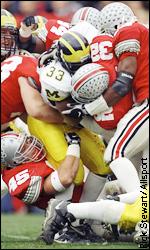| | We tend to take notice when there is something huge on the
line, such as a conference championship, a trip to a bowl
game, even the national title.
But rivalries in college football transcend what is at stake. The game itself is often
more important than its ramifications, which simply serve to
heighten the intensity.
|  | | There is nothing like the Wolverines and Buckeyes battling for bragging rights. |
The campuses at each school vibrate with anticipation, and
when teams that love to hate each other collide, the records
hardly matter.
Still, having something to play for makes the outcome all
the more delicious, simply because the winner knows that the
loser's suffering is magnified. And what would a great
rivalry be without the joy of standing over the vanquished,
the feeling of superiority?
That is what makes the annual
Michigan-Ohio State showdown, which is remarkable for its level of hatred, so emotional. The added irony of how often the combatants have met with something at stake makes the game the best rivalry of the century.
Consider this. Since the game between the Wolverines and
Buckeyes was moved to the final Saturday of the regular
season in 1935, Michigan and Ohio State have met 36 times
when the outcome had an impact on the Big Ten race. And in 17
of those encounters, the winner has gone on to represent the
Big Ten in the Rose Bowl.
One of the best matchups occurred in 1973, when Ohio State
was ranked No. 1 in the country and Michigan was No. 4. Both were undefeated. At
the time, the Big Ten champion went to the Rose Bowl and the
rest of the conference stayed home. The Rose Bowl was at
stake, of course.
"It was like time stood still that week," recalled OSU
quarterback Cornelius Greene. "Saturday took forever to get
there."
"The campus got real, well, silent as the game got
closer," said OSU linebacker Randy Gradishar. "You could
sense there was something different about this week. You
could feel the intensity building. Not just the players and
students. The faculty, the whole city of Columbus. It was the
perfect record, the polls, the conference championship and
the Rose Bowl trip, and of course the whole Bo (Schembechler)
and Woody (Hayes) thing."
|
The greatest rivalry
|
|
A year-by-year rundown of the Michigan-Ohio State rivalry beginning in 1969, the year Bo Schembechler took over as the Michigan coach. Records, with rankings in parentheses, are of each team heading into the yearly matchup: |
|
Year
|
Mich.
|
Ohio St.
|
Score
|
|
1969
|
7-2 (12)
|
8-0 (1)
|
M, 24-12
|
|
1970
|
9-0 (4)
|
8-0 (5)
|
O, 20-9
|
|
1971
|
10-0 (4)
|
6-3 (16)
|
M, 10-7
|
|
1972
|
10-0 (3)
|
8-1 (9)
|
O, 14-11
|
|
1973
|
10-0 (4)
|
9-0 (1)
|
T, 10-10
|
|
1974
|
10-0 (3)
|
9-1 (4)
|
O, 12-10
|
|
1975
|
8-0-2 (4)
|
10-0 (1)
|
O, 21-14
|
|
1976
|
9-1 (4)
|
8-1-1 (8)
|
M, 22-0
|
|
1977
|
9-1 (5)
|
9-1 (4)
|
M, 14-6
|
|
1978
|
9-1 (6)
|
7-2-1(16)
|
M, 14-3
|
|
1979
|
8-2 (13)
|
10-0 (2)
|
O, 18-15
|
|
1980
|
8-2 (10)
|
9-1 (5)
|
M, 9-3
|
|
1981
|
8-2 (7)
|
7-3 (-)
|
O, 14-9
|
|
1982
|
8-2 (13)
|
7-3 (-)
|
O, 24-14
|
|
1983
|
8-2 (8)
|
8-2 (10)
|
M, 24-21
|
|
1984
|
6-4 (-)
|
8-2 (11)
|
O, 21-6
|
|
1985
|
8-1-1 (6)
|
8-2 (12)
|
M, 27-17
|
|
1986
|
9-1 (6)
|
9-2 (7)
|
M, 26-24
|
|
1987
|
7-3 (-)
|
5-4-1 (-)
|
O, 23-20
|
|
1988
|
7-2-1(12)
|
4-5-1 (-)
|
M, 34-31
|
|
1989
|
9-1 (3)
|
8-2 (20)
|
M, 20-18
|
|
1990
|
7-3 (15)
|
7-2-1(19)
|
M, 16-13
|
|
1991
|
9-1 (4)
|
8-2 (18)
|
M, 31-3
|
|
1992
|
8-0-2 (6)
|
8-2 (17)
|
T, 13-13
|
|
1993
|
6-4 (-)
|
9-0-1 (5)
|
M, 28-0
|
|
1994
|
7-3 (15)
|
8-3 (22)
|
O, 22-6
|
|
1995
|
8-3 (18)
|
11-0 (2)
|
M, 31-23
|
|
1996
|
7-3 (21)
|
10-0 (2)
|
M, 13-9
|
|
1997
|
10-0 (1)
|
10-1 (4)
|
M, 20-14
|
|
1998
|
7-2 (13)
|
9-1 (4)
|
O, 31-16
|
|
1999
|
8-2 (8)
|
6-5 (-)
|
M, 24-17
|
Dennis Franklin, the Michigan quarterback, said: "I
remember this one German professor; she taught calculus and
she couldn't stand athletes. If you were an athlete, she
wouldn't even talk to you and if you came in unprepared you
were going to suffer. That particular week, she smiled at us.
That's about it, but it was a major victory."
OSU jumped out to a 10-0 lead, but Michigan rallied in the
fourth quarter, tying the game on a 10-yard run by Franklin,
shortly before he broke his collarbone. The game ended 10-10
-- ties were not decided in overtime then -- so the Rose Bowl
trip came down to, of all things, a vote of Big Ten athletic
directors.
The vote went in favor of the Buckeyes, with Big Ten
commissioner Wayne Duke indicating that OSU got the nod
because the Wolverines would likely be without Franklin for
the Rose Bowl.
What makes a game such as Michigan-Ohio State so
important?
Perhaps it is because familiarity breeds contempt. Just
like in the annual Florida-Florida State matchup, or
Auburn-Alabama, or USC-UCLA, or Texas-Oklahoma, or
Georgia-Georgia Tech, the teams know each other so well.
Many of the players grew up with the rivalry, and may have
even rooted for the other team. Fans and alums live near each
other and work together, meaning they must deal with the
outcome for a whole year until the next game is played.
In fact, sometimes the pain of losing is far greater than
the joy of winning.
Just ask Florida State coach Bobby Bowden, who once
endured a six-game losing streak to rival Florida. On
recruiting trips, at golf outings, during speaking
engagements, that topic was bound to come up.
"It's an inferior feeling," Bowden said. "When you have
to travel up and down the state all year like I do and catch
that all the time."
Bowden, of course, has bragging rights this year. His
Seminoles knocked off the Gators for the chance to play for
the national championship. They did so three years ago, too
-- then had to play Florida in the Sugar Bowl, which the
Gators won for the national title.
In that case, it becomes more than a rivalry.
Others know the feeling.
Johnny Rodgers, the 1972 Heisman Trophy winner, will never
forget his Nebraska team's 35-31 victory over Oklahoma in
1971. The teams were ranked first and second in the nation.
"It seems like everyone I run across nowadays says they
were there. And they all remember it like yesterday," said
Rodgers, who had a 72-yard punt return for a touchdown. "The
intensity the week before the game was easily three or four
times what it was the year before.
"This time, we were out to prove we were the best, and at
the same time, Oklahoma, our biggest rival ever, they were
out to prove they were. The whole campus was nuts the whole
week. You couldn't take five steps without someone telling
you to win. Not just wishing you luck; telling you to win."
Another classic came in 1967, when No. 4 USC upset No. 1
UCLA 21-20. The fuse had been lit the year before when the
Trojans lost 14-7 to the Bruins in 1966. One week later, they
were defeated 51-0 by Notre Dame and finished the season at
7-3 to UCLA's 9-1.
But the Pacific-8 didn't require teams to play an equal
number of conference games. So the day after the loss to the
Bruins, USC, 4-1 in the Pac-8 to UCLA's 3-1, was voted into
the Rose Bowl by conference athletic directors.
"The (UCLA) students held this big rally on the campus,
waiting for the vote," said Bruins running back Greg Jones.
"Because we knew we were going to picked. When they picked
SC, the students marched to the San Diego Freeway about a
mile away and shut it down as a protest.
"So we had the Rose Bowl on our minds, plus maybe going
to this one, plus the national championship, plus the
Beban-Simpson thing. All of that riding on this one game."
In the game, UCLA quarterback Gary Beban passed for 301
yards and two touchdowns, but USC tailback O.J. Simpson ran
for 177 yards, including 147 in the second half, and two
touchdowns, the second one 64 yards in the fourth quarter for
the winning score.
Despite the loss, Beban won the Heisman Trophy in 1967;
Simpson would win in 1968.
That's what helps make these college football rivalries so
great. The venom and adrenaline, ignited by years of
tradition, routinely collide with the knowledge that next
year promises to be even better.
| |
ALSO SEE
ESPN.com's 10 greatest rivalries
Message Board
 |



